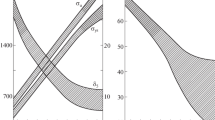Abstract
There are a number of two-phase alloys which are technologically important. These include α-β titanium alloys and two-phase steels. Modeling of deformation of such alloys, however, is a difficult task for the simple reason that a number of factors have to be considered simultaneously. Whenever a metal consisting of more than one-phase with different stress-strain behavior is subjected to stress, neither the stresses nor the strains are constant. The softer phase deforms more than the harder phase. The actual stress and strain distributions depend on the morphology of phases. Therefore, the simple law of mixtures rule is inadequate to study stress/strain behavior in these two phase materials. The Finite Element Method (FEM), which has been successfully used for stress analysis, appears to be a viable tool for studying stress-strain behavior of two-phase materials. Some of the predictions of FEM were corroborated by experiment. With some improvements in computer programs dealing with FEM, this method can be applied for various problems of stress-strain and fracture behavior in two-phase materials.
Similar content being viewed by others
References
J. Jinoch, S. Ankem and H. Margolin, Mater. Science & Eng., 34 (1978), p. 203.
R.G. Davies, Metall. Trans., 9A (1978), p. 41.
R.G. Davies, Metall. Trans., 9A (1978), p. 451.
R.G. Davies, Metall. Trans., 9A (1978), p. 67.
H.W. Hayden and S. Floreen, Metall. Trans., 1 (1970), p. 1955.
A.R. Marder, Metall. Trans., 12A (1981), p. 1509.
A.H. Yegneswaran and K. Tangri, Metall. Trans., 14A (1983), p. 2407.
A.H. Yegneswaran and K. Tangri, Metal Science, 18 (1984), p. 161.
S. Ankem and H. Margolin, Metall. Trans., 13A (1982), p. 595.
D. Tseng and K. Tangri, Metall. Trans., 13A (1982), p. 1077.
I. Tamura, Y. Tomota and M. Ogawa, Proc. Third International Conference on Strength of Metals & Alloys, Inst, of Metal, London, 1 (1973), p. 611.
R.N. Wright and J.R. Wood, Metall. Trans., 8A (1977), p. 2007.
A.A. Hussein, Metall. Trans., 13A (1982), p. 847.
M.F. Ashby, Phil. Mag., 21 (1970), p. 399.
I. Tamura, Y. Tomota, A. Akao, Y. Yamoka, M. Ogawa and S. Kanatoni, Trans. Iron & Steel Inst., Japan, 13 (1973), p. 283.
B. Karlsson and B.O. Sandstrom, Mater. Sci. & Eng., 16 (1974), p. 161.
Y. Tomota, K. Kuroki and I. Tamura, J. Iron & Steel Inst., Japan, 61 (1975), p. 107.
T. Nakamura and K. Wakasa, Trans. Iron & Steel Inst., Japan, 16 (1976), p. 134.
H. Fischmeister and B. Karlsson, Z. Metallk., 68 (1977), p. 311.
T. Inoue and S. Kinostita, Trans. Iron & Steel Inst., Japan, 17 (1977), p. 245.
J.J. Petrovic and A.K. Vasudevan, Mater. Sci. & Eng., 34 (1978), p. 39.
G. Linden, Mater. Sci. & Eng., 40 (1979), p. 5.
S. Ankem and H. Margolin, Metall. Trans., 11A (1980), p. 963.
S. Ankem and H. Margolin, Metall. Trans., 13A (1982), p. 603.
Y. Tomota, K. Kuroki, T. Mori and J. Tamura, Mater. Sci. & Eng., 24 (1976), p. 85.
N.C. Goel, S. Sangal and K. Tangri, Metall. Trans., 16A (1985), p. 2013.
S. Sangal and K. Tangri, Metall. Trans., 16A (1985) Ibid, p. 2023.
K.S. Chan, C.C. Woscik and D.A. Koss, Metall. Trans., 12A (1981), p. 1899.
H. Fischmeister, J.O. Hjälmered, B. Karlsson, G. Linden and B. Sundström, Proc. Third Int. Conf. Strength of Metals & Alloys, Inst, of Metals & Iron and Steel Inst., Cambridge and London, 1973, Vol. 1, p. 621.
B. Karlsson and B.O. Sundström, Mater. Sci. Eng., 16 (1974), p. 161.
B.O. Jaensson and B.O. Sundström, Mater. Sci. Eng., 9 (1972), p. 217.
B.O. Sundström, Mater. Sci. Eng., 12 (1973), p. 265.
O.C. Zienkiewicz, The Finite Element Method in Engineering Science, McGraw-Hill, New York, 1971.
C.W. McCormick (Ed.), NASTRAN Users Manual Level 15.5, May 1973, Document NASA ST [(222)01], Published by National Aeronautics & Space Administration, Washington, D.C.
K. Hashimoto and H. Margolin, Acta Met. 1983, Vol. 31, p. 773.
H. Hashimoto and H. Margolin, Acta. Met. 1983, Vol. 31, p. 787.
N. Thompson, Fracture, B.L. Averbach, D.K. Felbeck, G.T. Hahn and D.A. Thomas, Eds., John Wiley & Sons, New York, 1959, p. 354.
R.C. Boettner, A.J. McEvily and Y.C. Liu, Phil Mag., 1964, Vol. 10, p. 95.
Z.R. Wang and H. Margolin, Met. Trans., 1985, Vol. 16A, p. 873.
Additional information
S. Ankem received his Ph.D. from the Polytechnic University of Brooklyn, New York in 1980. He is currently an Associate Professor in the Department of Chemical & Nuclear Engineering at the University of Maryland. Professor Ankem is also a Member of TMS.
H. Margolin is currently a Professor in the Department of Metallurgy and Materials Science at the Polytechnic University in Brooklyn, New York. Professor Margolin is also a Member of TMS.
Rights and permissions
About this article
Cite this article
Ankem, S., Margolin, H. Modeling Deformation in Two-Phase Alloys. JOM 38, 25–29 (1986). https://doi.org/10.1007/BF03257865
Published:
Issue Date:
DOI: https://doi.org/10.1007/BF03257865



